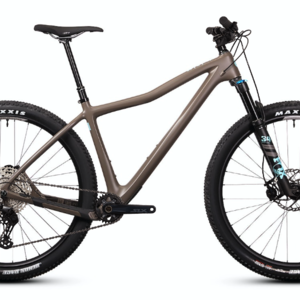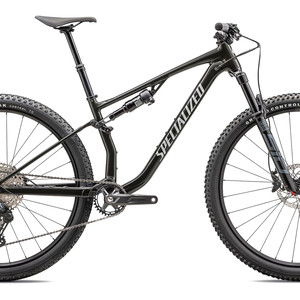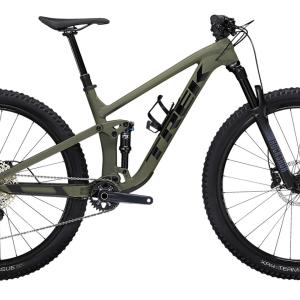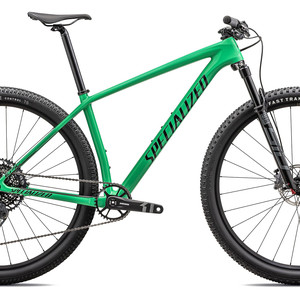2016 Trek Stache 9 29+ Bike
(discontinued)
| Where To Buy | |||
|---|---|---|---|
Free standard shipping on all bikes (continental U.S. only).
Flat rate shipping to Hawaii and Alaska. |
Free standard shipping on all bikes (continental U.S. only).
Flat rate shipping to Hawaii and Alaska. $1,599.97
|
||
Stache C Frameset
$1,599.97
|
|||
Stache AL Frameset
$1,199.99
|
|||
Free shipping on orders over $50 (continental U.S. only).
International shipping available. Some exclusions apply. |
|||
Free shipping on orders over $50 (continental U.S. only).
International shipping available. Some exclusions apply. |
|||

By gordo
If you're reading this review, I figure you have one of three attitudes toward the 29+ tire size:
- Why would this clown bike be reviewed on Vital? I'm going to hate on it in the comments because that's what any cool mountain biker would do.
- I'm actually interested in the wheel/tire platform and how this bike rides.
- What the heck is that thing, I know nothing about it.
If you have attitude #1, you can skip to the comments and leave your territorial pissings. Your internet friends will approve of your hate and your life will go on. If you have attitude #2 or #3, keep reading.
Trek Stache 9 29+ Highlights
- 29 x 3.0-inch Bontrager Chupacabra 29+ tires
- 329mm BB height
- 420mm chainstay length
- 68.4-degree head angle
- Boost148/110 axles
- Stranglehold dropout gives options 29+, 27.5+, or 29er (Vital only tested 29+ as this is the complete bike option)
- Manitou Magnum Pro fork, 110mm travel
- DT Swiss 350 hubs
- SRAM X1 drivetrain
- Shimano Deore XT brakes
- KS eThirty Integra dropper post
- $3699.00

Why Did Vital Test This Bike?
I used to be a #1. I first saw the Stache 29+ bikes at Sea Otter this year. I'm not a fat biker, I'm not hip to the niche trends outside of gravity bikes and basically laughed at the thing the first time I saw it during a Hayes/Manitou presentation. I really didn't understand why this bike existed. This fat bike stepchild seemed like a complete novelty, or even a joke, on display during the presentation.
As I drove home from Sea Otter, the thought crossed my mind to give it a test. It's the most punk rock thing Vital could do, right? If I were to ask for one of these bikes to test, most of the people I know would think I lost it. You readers may think we were trying to turn into The Vitavist, plus I would get the chance to hate on this goofy-looking contraption.
I mulled over asking for a Stache to test and discussed the idea internally. We all agreed (well, except for maybe Brandon) that it was worth a shot. Let's do it. I wrote Trek and asked for the mid-priced Stache 7 29+. They said yep. I wrote this article before the bike showed up and not too long after, a Stache 9 29+ (oohhh, upgrade!) arrived at my doorstep. That was a while ago.
I received the bike and coincidentally my back went out a day or two later. Karma? I was fully out of commission from riding for about a month. The bike sat in the box for two weeks. When I was healed up enough to build the bike, I put it together and just looked at it. "What have I done?" I had tester's remorse for sure. I was not used to how the bike looked. The wheels were just too huge.

Since I couldn't ride the bike and I had absolutely no clue about the platform, I did some research and realized 29+ wasn't brand new. Some small brands had figured out how to cram those huge tires into a frame that complied with typical geometries and drivetrain technologies. I read some other reviews on the Stache 29+ to see what I might expect. It sounded like the biggest piece of innovation with the Trek were the light-weight Bontrager Chupacabra tires. The tires are what make the difference on the Stache. At 850 grams, the Chupacabras are in the ballpark of popular 27.5 trail bike tires. Other 29+ attempts still had heavier tires which made the ride feel more fat bike-like. Additionally, the geometry of the Stache is compact despite the massive tires, keeping angles and measurements similar to other trail rippers. By the time my back was healed enough to ride, I understood the standards, sizes, tire pressures and the design ideology of the bike. All I had to do was ride it and see for myself.
Initial Impressions
It's a funny thing having to sit there and look at your bike without being able to ride it. A few weeks after building it up, I was now used to the cosmetics of the bike. It looked "right." I'd look at my personal trail bike with 26-inch wheels (yes, my personal bike is still a 26) sitting in the garage next to the Stache and my personal bike looked like the clown bike now, not the Stache.

Setup
The Manitou Magnum fork is stout, but the Hexlock thru-axle system wasn't very intuitive for this guy. I had to read the instructions a few times to get the wheel on, which is pretty comical in hindsight. The lever needs to be in a certain position to get the axle all the way in, then you push it in to turn it 90-degrees and flip it up. It only flips one way, so half the time, the "flip" would leave the lever pointing down toward the ground, not up along the fork leg. I eventually figured it out and installing the front wheel has become old-hat, but the Hexlock system seems a lot more complicated than it needs to be. I was also not getting full travel out of the box. A quick consultation with Manitou led me to reset the negative spring and all was right with the fork. I set the fork to the upper end of air spring and compression using their recommendations for weight and riding style as a baseline. They use "Trail" or "Enduro" labels in their tuning with "Enduro" set up focused more on gravity performance, so I went with that.

Reviews I read had tire pressures in the 13-15psi range. No way was I going that low. I'm a fat bike and plus-size noob, so I went 17psi for the first ride. 17psi in the Chupacabras made the tires feel incredibly hard, but I erred on the side of too much for ride number one. The SRAM X1 1x drivetrain is the only option on the bike because of the tire size, so 2x fans look elsewhere. The Bontrager components are solid as expected with Rhythm Pro carbon bars at a nice 750mm width. Shimano XT brakes are a nice touch, as I'm personally a fan of the lever shape and brake modulation. This was my first time riding a KS Lev dropper post.

On The Trail
The Fire Road
Since my back was on the mend, my first two rides were up a fire road, descending right back down it. It's the closest ride to my house and easy to knock out in about 90-minutes. There's a two mile bike path to warm up, then a steady, non-tech grind for as long as you want to go. I aim for a vista about 4 miles up. On my trail bike with aggressive front tire and mid-range rear tire, this climb kind of feels like a slog. It's a mental challenge because I know I could ride this fire road on any bike and the trail bike is overkill. I only ride it to get out and spin. The Stache put me in a different headspace here. Riding a new bike is always fun, but on the path to the fire road and on the dirt, the thing rolled a lot faster than I would have ever thought it would considering width and size of the tires. Since I was on the higher end of the pressure range at 17psi, maybe that was it.
I have a designated stop on this fire road about two-thirds of the way up when I ride my trail bike. I rode right by the stop, pretty blown away that I wasn't sucking the wind I'm usually sucking. I was also there a lot more quickly than normal. That was inspiring and my first thought was, "wow, this 29+ stuff really works!" Well, it does work, but let's look at what I'm comparing. I'm on a hardtail and it has large diameter wheels and tires with pretty small knobs, so of course the Stache is going to climb a fire road better than my 26-inch trail bike. Is it as fast as a 29er race hardtail? No. But the change of pace on this particular ride was refreshing and inspiring. I hit the 4-mile lookout and was ready for more uphilling which almost never happens considering my weekend-warrior-keyboard-jockey-new-dad physique. The svelte design of the Chupacabra tires paid off.
Riding down the fire road was pretty sick too. I had a conversation about the tire size and contact patch with an experienced pro MTB friend and he thought the tire footprint would make a great Kamikaze/fire road-slaying tool because grip should be all-time. Grip was surprisingly all-time despite the low-profile knobs on the Chupacabras. I'm not skilled enough to slide bikes into fire road corners at 40mph, and while I like to deceive myself into thinking I'm Sam Hill when the tires lose traction a bit, it's usually more fright than fun. The Stache, despite the visually short-looking wheelbase and actually short chainstays, was stable on the descent at speed. I never heard the front tire break loose and the rear tire held the line even with some crunchy, gravel sounds of slight slip. It was a bit weird trying to lean over those tall wheels, but by the bottom of the first ride I felt used to it and those massive gyroscopes helped with stability at speed. A few days later, the second time descending the same road was faster and more aggressive as I realized the bike could be pushed more. It was a blast and I'd love to see a legit pro on this tire platform ripping some fire road corners. I was happy with the 17psi, too. I did not change that from the first ride to the second on the fire road.

The Too-Tech Trail
Time for a ride on a rough trail. I went to the complete opposite end of the spectrum for the next rides; a singletrack trail that is pretty steep, switchbacky and filled with big boulders and trials-like moves going uphill. These trialsy moves are really fun on the descent. It's a trail I don't normally ride because overall, the uphill doesn't make the descent worth it on my limited time out.
I knew I'd be walking up half of this trail because I'm fat, but even super fit riders with skills would be walking a majority of the sections. I wanted to see how this bike would handle some of the rock stairs on the way up, but mostly on the way down. Could I just monster truck them all where I'd normally be slipping and hitting pedals and chainrings? Would the hole-filled rock gardens on the 26-inch feel like mild washboards now on the 29+? That's what these massive wheels are meant for, right? Mobbing shit.
The climb was definitely more successful than on the 26. I blame part of that on the hardtail factor, but the tires with their huge footprint, diameter and lower pressures were grabbing pieces of rock and straddling holes that would normally stop me dead. Navigating tight, slow switchbacks felt more awkward because of the big wheels, but I can't recall thinking any corner was unmakeable purely because of the wheel size. Aside from the really tight, slow navigation, the Stache felt pretty "normal" to me. The geometry, featuring short chainstays for the tire size and a low bottom bracket height, keep the center of gravity low and the bike nimble. The rear tire's forward position, means that high-centering or striking pedals isn't an issue.
I suffered to the top and was fired up to blitz back down. I was a little concerned dropping in thinking that I hadn't ridden a hardtail on tech trail in a LONG time. Once I passed the first two rocky sections, I realized this bike was not a 5-inch trail bike. There was some teeth-rattling going on, but it was fun as shit. I opened it up a bit more and had some wide-eyed moments on the faster sections of trail. Through the really tech, slower spots, the Stache did seem to ride over holes I'd normally try to avoid or get really hung up on and again.

The Magnum fork (110mm travel) performed well in conjunction with the massive wheels. A click or two of adjustment within the recommended settings were all I needed to find a happy place on the rough trail. I got so cocky with the monster truckness of the bike that on the last tech feature at the end of the trail, I tried a line I'd have never considered on my 26-inch bike and just barely stuffed the front wheel into a hole and went OTB onto my face. I guess the Stache can't roll over everything...
I still had the bike at 17psi on that first ride and liked that pressure. I never heard the rim ping a rock which was probably the most surprising sensation of taking a hardtail down a rock-filled trail. It bounced around more than a full suspension bike (duh), so I rode the trail again a few days later at 14psi to compare. I felt that pressure was a little too squirrely for my liking. I still never bottomed-out the rim, and climbing traction was a bit better, but it just felt a little more "floaty" descending and cornering, as if the tires were rolling a bit. I went back to 16-17psi and have stayed there.

Long Term Durability
There's nothing on the Stache 29+ that really stands out as a compromise in durability. It's an aluminum hardtail with proven, quality components. The KS Lev seatpost has performed as advertised and the SRAM X1 drivetrain is as clean as they come. I would consider the limited tire options (at the time of writing) as something to think about. The tires have performed really well and are not wearing too quickly. If there was a catastrophic tire event, like a slice or cut however, you may be out of commission until you can get one of the less-than-common Chupacabras from Trek/Bontrager should your local Trek dealer be out of stock. The tires are also pretty spendy at $119 each, full retail.

What's The Bottom Line?
The experienced trail bike rider who knows their local trails in their sleep will have a lot of fun on the Stache 29+. The bike brings a completely new and fun sensation to trails that may have become boring. The sensation is not that of a lumbering pig either. It's snappy, responsive, efficient and alive. The rider looking to expand their quiver should look to this side of the spectrum.
The new or less-experienced rider would do well to consider the Stache, too; especially the Stache 7 29+ at only $2499. If I was looking to buy a new bike and only had $2500 to spend, I now know how much fun could be had on the 29+ wheel platform when compared to a similarly-priced full-suspension bike. The build spec, the simplicity of a hardtail and the shredability of the finished product is worth a look.
I'd like to be very clear - the Stache does not ride like a 4- or 5-inch trail bike. A few reviews I read mentioned the Stache was just like their full-suspension bikes. Those reviewers are delirious or didn't ride the Stache in the right place. The Stache 29+ is a hardtail with some compliance in the rear, but it is NOT a replacement for suspension. If anyone presented a 2-inch full suspension frame featuring an air shock with no rebound or damping control, you'd laugh. Well, that's what the tires are. They do take some of the hardtail sting away from the ride, but they're not plush. If you're expecting suspension like a Remedy, you should just buy a Remedy. If you're willing to broaden your horizons and are looking for that hardtail thrill again, you will have a blast on the Stache 29+ bikes.
Visit www.trekbikes.com for more info on the Stache 9 29+.
About the Reviewer
Shawn Spomer has been mountain biking since 1998 and has been involved in mountain bike media since 2001. He has been with Vital MTB as Content Director since 2009. While he may be more keyboard jockey than talented rider these days, his experience on the bike gives him the insight to investigate how a product will relate to the majority of consumers.
Specifications
The Stache is an all-new species of 29+ mountain bike performance. The wide 3" tires grip relentlessly, amplifying all the benefits of 29ers, while remarkably short chainstays deliver a fun, lively ride.
Key Features
- 110mm travel and 29+ wheels let you roll over anything
- Shorter chainstays give you a spirited, lively ride
- Boost148/110: wider = stiffer, for unprecedented 29er control
- Stranglehold dropout gives you options: 29+, 27.5+, or 29er
| Where To Buy | |||
|---|---|---|---|
Free standard shipping on all bikes (continental U.S. only).
Flat rate shipping to Hawaii and Alaska. |
Free standard shipping on all bikes (continental U.S. only).
Flat rate shipping to Hawaii and Alaska. $1,599.97
|
||
Stache C Frameset
$1,599.97
|
|||
Stache AL Frameset
$1,199.99
|
|||
Free shipping on orders over $50 (continental U.S. only).
International shipping available. Some exclusions apply. |
|||
Free shipping on orders over $50 (continental U.S. only).
International shipping available. Some exclusions apply. |
|||

























16 comments
Post a reply to: Tested: Trek Stache 9 29+